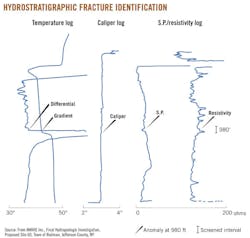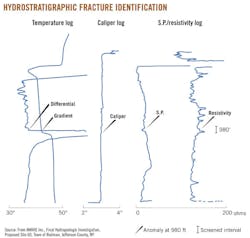John Robinson
Dewberry
Parsippany, NJ
This article was written to express a professional opinion regarding the use of available groundwater technology to reduce both real and perceived water quality impacts from shale gas hydraulic fracturing (fracing) operations, particularly in the Marcellus shale.
As the natural gas industry marches forward in the Marcellus shale gas play in West Virginia, Pennsylvania, New York, and Ohio, federal and state agencies struggle with the development of new regulations to protect human health and the environment.
In 2011, Pennsylvania greatly modified its Oil and Gas Regulations Code; New York prepared an Oil, Gas, and Solution Mining supplemental draft generic environmental impact statement (SGEIS) for public comment; and the US Environmental Protection Agency released a draft hydraulic fracture treatment (hydraulic fracturing or fracing) study plan.
The regulatory climate is changing in an attempt to keep up with the evolution of unconventional natural gas production technology.
The technique of hydraulic fracturing has been demonized in the general media as a high-risk activity due to reported impairments of potable well water in the vicinity of drilling activities. Representatives from the gas industry insist that fracing is safe, assuming that the gas well is installed properly.
However, the possibility exists that many of the reported groundwater impairments blamed on hydraulic fracing may have occurred much earlier in the drilling process (such as lost circulation during drilling and casing installation) or are the result of surface activities including leaking impoundments.
In addition, Pennsylvania is one of the few states that has not adopted construction standards for domestic wells, and many potable wells in pre-gas drilling areas are already impaired with naturally occurring constituents such as arsenic, radon, and coliform bacteria. This article proposes several solutions to reduce the risks associated with natural gas drilling operations.
Actual and perceived hazards
Environmental risk can be characterized as the sum of the actual hazard and perceived hazard.
The risks associated with the impairment of drinking water from gas shale hydraulic fracing will persist as long as the perceived hazards from these operations remain.
Current industry best practices, such as installation of protective telescoping casing that isolates the gas well from water supply aquifers, can greatly reduce the actual hazards associated with hydraulic fracing. It is generally agreed in the industry that downhole hydraulic fracing is, in itself, not a threat to drinking water assuming that the protective casing is properly installed.
In February 2011, Chapter 78 of the Pennsylvania Code (Oil & Gas Regulations) was greatly modified to address a number of safety issues including blowout prevention, replacement of damaged water supplies, and casing and cementing.
An important question facing Marcellus fairway stakeholders is: What constitutes "properly installed" casing, and do the new regulations go far enough to minimize both the actual and perceived risks?
Subchapter D of the Pennsylvania Code, Section 78.83 (b), entitled "Casing and Cementing—Lost Circulation," indicates that (a) "If cement used to permanently cement the surface or coal protective casing is not circulated to the surface despite pumping a volume of cement equal to or greater than 120% of the calculated annular space, the operator shall determine the top of the cement, notify the Department, and meet one of the following requirements as approved by the Department...."
This regulation describes actions for addressing lost cement circulation, but at this juncture of the drilling process groundwater impairments from excessive turbidity, lowered pH, and mobilization of naturally occurring elements such as arsenic would have already occurred.
Lost cement circulation and associated formation invasion occurring within drinking water aquifers will likely be preceded by a similar loss of drilling fluid circulation. The increased head of drilling fluids that intersect permeable bedrock fractures or solution zones in carbonates would likely contribute to formation invasions. This condition could impair drinking water quality with excessive turbidity and other additives, and might be misinterpreted as impacts resulting from fracing.
Until the public is informed as to what exactly "properly installed" casing comprises, the perceived risks associated with shale gas exploration and production will persist. A solution that might be helpful is an expansion of public outreach by regional petroleum industry operators (similar to the current fracing outreach) regarding the proper installation of protective casing.
The presentation of details such as the standard use of centralizers, cement cure times, and the use of concrete additives designed to reduce shrinking and cracking might be helpful in demonstrating the safeguards the industry has established to minimize and-or eliminate groundwater impacts.
As a start, current educational web sites with features that document the technical aspects of fracing can add content to document the technical aspects of protective casing installation and to promote potable residential well construction best management practices.
Standard aquifer evaluation
A solution for reducing the actual drilling risk would be to adopt standard aquifer evaluation methods currently employed by the groundwater industry.
These methods could be used to preempt catastrophic lost circulation prior to the installation of well casings. The environmental installation of protective casing and associated investigative methods are commonly employed to test deeper potable water-bearing zones underlying shallow contaminant plumes.
Application of these methods to shale gas production would require additional time (and cost) for the completion of each gas well but can be conducted in conjunction with determining the "deepest fresh groundwater" as required by PA Chapter 78.83(a)(2)(c).
In this exploration scenario, the Marcellus is the fracing target, and the aquifer is treated as an "unconventional" protection target. Risk reduction can be accomplished by conducting a detailed evaluation of the aquifer characteristics beneath each well site using the following:
• A dedicated drilling rig to work the deepest fresh groundwater zone.
• Bedrock core collection and evaluation.
• Borehole geophysical logging.
• Packer pressure testing.
• Groundwater sampling to document base of deepest fresh groundwater zone.
The use of a lower-cost secondary drilling rig capable of installing the desired telescoping casing diameters to below the assumed aquifer depth of 1,000 ft could both reduce the cost of the larger land-based rig, and relax the exploration and production schedule. Each individual well's surface and protective aquifer casings could be "properly installed" prior to mobilization of the larger rig.
The additional cost of this secondary spud rig would be partially offset by reduced time needed for the primary land-based rig. Once the "deepest first groundwater" is safely cased off, production can focus on drilling and installing 95⁄8-in. casing to just above the Marcellus, and the final horizontal leg.
This extra step (estimated 3-4 field days/well) would provide the adequate time necessary to conduct aquifer evaluation and cement bond testing, correct deficiencies, and allow for all cement seals to properly cure beyond the required minimum wait on cement (WOC) period of 8 hr.
Addressing potential lost-circulation problems with the spud rig would reduce more costly production downtime needed for plugging the formation and reduce costs associated with replacing damaged water supplies.
The evaluation of the aquifer can be accomplished by first collecting bedrock core (wireline NQ, HQ, or PQ) for visual description and rock quality designation (RQD) to identify sensitive fracture zones.
A suite of nonnuclear borehole geophysical tools, including spontaneous potential, single-point resistance, caliper, gamma ray, temperature (gradient and differential), acoustic and visual televiewer, flowmeter, and water quality probe can be employed for each casing interval to detect specific bedrock water-bearing fractures and "hydrostratigraphic" flow zones vulnerable to lost circulation including the invasion of drilling fluids and casing cement residuals.
For best logging results, it is required to both develop the corehole (conducted by evacuating corehole water to remove drill cuttings from fractures and sidewall, expel total suspended solids from the formation, and is generally considered complete when variations in turbidity measurements are less than 10%) and allow time for groundwater temperature equilibration (typically overnight) prior to running the geophysical suite. Please note the comparison of temperature, caliper, and electric logs across a hydrostratigraphic fracture in the Whetstone Gulf shale located in Rodman, NY (Fig. 1).
Historic investigations of bedrock aquifers have operated under the assumption that groundwater flow through bedrock will generally be controlled by the size, frequency, and orientation of fractures within the rock. In the northern US, many horizontal bedding plane fractures are theorized to have been caused by vertical stress relief that resulted from isostatic rebound following the melting of the Laurentide Ice Sheet. In relatively flat-lying sedimentary bedrock, horizontal fractures oriented parallel or subparallel to bedding commonly control the direction and magnitude of groundwater flow, and this property can be applied to evaluating potential zones of lost circulation prior to casing installation.
Continuous downhole packer pressure testing with dual packers separated by a perforated pipe can be further used to confirm groundwater flow zones identified in drill core and the geophysical logs.
The packers are inflated with nitrogen to seal off the test interval, and water is injected into the test interval at a constant pressure. The flow of water into the rock is gauged at the surface, and the results of the packer pressure testing are also used to determine the hydraulic conductivity of each test interval.
Individual flow zones can also be isolated with inflatable packers and sampled for water quality parameters such as salinity and total dissolved solids to document the base of the fresh water aquifer and top of saline groundwater. This information is critical in determining the depth of this section of protective casing which is 50 ft below the base of the "deepest fresh groundwater" as required by PA 78.83(c).
Preventing lost circulation
The up-front identification of specific fracture-flow zones provides an opportunity for addressing fractured bedrock aquifer zones vulnerable to catastrophic loss of circulation prior to borehole enlargement and the installation of protective casing.
This identification of fractures may be especially beneficial for reducing fluid loss in highly permeable intervals such as faulted shear-zones and karst-solution features in carbonates and would provide an opportunity to conduct grout repair before completely drilling through the zone.
Under the new regulations, the fate and transport of turbid drilling fluids and grout residuals may intercept potable wells through formation loss during nonfracing drilling activities. This condition may also be exacerbated by the current lack of residential potable well construction regulations. Consequently, simple turbidity generated by routine and seemingly benign drilling and casing installation has the potential to perpetuate the perceived hazards of fracing.
The routine adoption of existing groundwater technology for shale gas operations may reduce both actual and perceived risks of fracing, foster improved community and regulatory relations, and help to remove obstacles that threaten to prevent timely build-out of the shale gas industry.
The author
More Oil & Gas Journal Current Issue Articles
More Oil & Gas Journal Archives Issue Articles
View Oil and Gas Articles on PennEnergy.com


